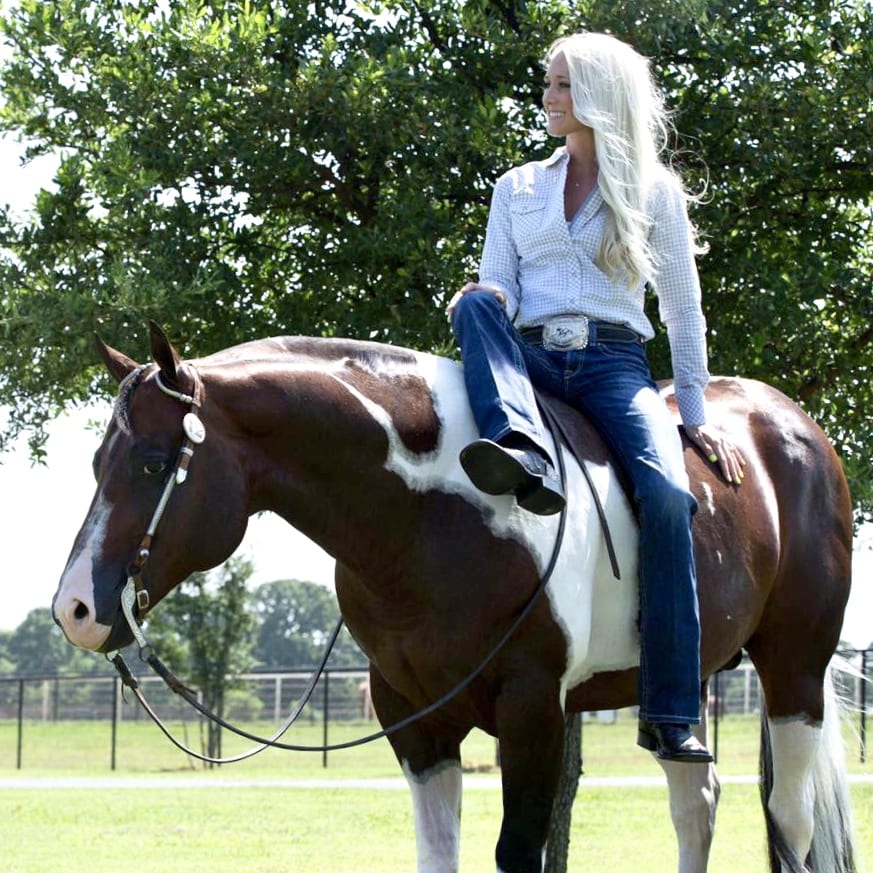Have you ever wondered how stallion owners decide whether to raise or purchase them? Or how they choose where to stand their stud or what to use to promote them within the industry? Stallion owners are faced with decisions like these and many more in the beginning stages of presenting their horse to the public.
We decided to find the answers to these questions and determine how owners in our industry have turned their horses into what they are today.
In Part 1, we spoke with reputable stallion owners Kari Craft, Erin Bradshaw, Katie Nicoletti and Jane Backes about the first steps of owning a stud.
Making the Decision
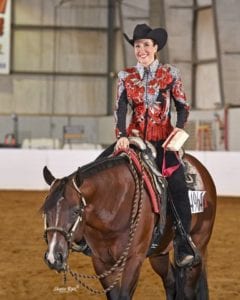 Choosing to own and stand your stallion is a big decision. Being prepared in all facets is a necessity. Kari Craft, owner of the up and coming AQHA stallion, Gone Viral (pictured right), knows there is a lot that comes with this decision.
Choosing to own and stand your stallion is a big decision. Being prepared in all facets is a necessity. Kari Craft, owner of the up and coming AQHA stallion, Gone Viral (pictured right), knows there is a lot that comes with this decision.
“Making sure that you, as a showman, are on your tip-top game to make sure you can show them to the best of their abilities is probably the biggest,” Craft said. “I also sit back and look at several other stallion owners that I admire, and watch what they do and decide what I like and what I may not like.”
Erin Bradshaw, the owner of well-known APHA stallion John Simon (pictured below, left), believes a good pedigree is essential for a successful beginning.
 “I’m huge on pedigree,” Bradshaw said. “Going off strictly who a horse is sired by is simply not enough for me to choose a breeding stud. I passionately believe you’ve got to have maternal lines to back them. If you are going to go looking for a breeding stud, you’re going to need to spend the money. It’s not something you want to get into cheap. If you’re going to buy a stud, go big. You’re ultimately putting those foals out into the industry and creating part of the future.”
“I’m huge on pedigree,” Bradshaw said. “Going off strictly who a horse is sired by is simply not enough for me to choose a breeding stud. I passionately believe you’ve got to have maternal lines to back them. If you are going to go looking for a breeding stud, you’re going to need to spend the money. It’s not something you want to get into cheap. If you’re going to buy a stud, go big. You’re ultimately putting those foals out into the industry and creating part of the future.”
Purchase or Raise?
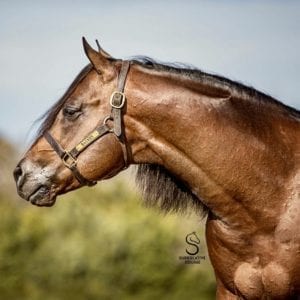 A big choice owners have to make is whether to buy a stallion or raise one from day one. There are challenges with both options. Jane Backes, the owner of proven AQHA stallion, Good Machinery (pictured right), thinks both are excellent opportunities.
A big choice owners have to make is whether to buy a stallion or raise one from day one. There are challenges with both options. Jane Backes, the owner of proven AQHA stallion, Good Machinery (pictured right), thinks both are excellent opportunities.
“It is by far easier to go buy a young stallion than to raise one,” Backes said. “Just like buying a foal or a two-year-old to ride, most of the guesswork is out when you buy a horse already going around. For the diehard breeders like myself, the true joy and accomplishment know every step of the way ‘he’ is your blood, sweat and tears.”
The Location
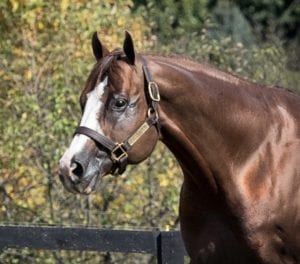 Having a breeding location, you can trust and depend on is important for owners. Their stallions are part of their family, and they are putting them in the hands of someone else. Katie Nicoletti, owner of the established stallion, Just Expect It, knew she made the right decision keeping “Patch” (pictured left) at Roger Landis and Debbi Trubee’s North Farm. Patch is owned in partnership with Kelly and Thad Woodlief.
Having a breeding location, you can trust and depend on is important for owners. Their stallions are part of their family, and they are putting them in the hands of someone else. Katie Nicoletti, owner of the established stallion, Just Expect It, knew she made the right decision keeping “Patch” (pictured left) at Roger Landis and Debbi Trubee’s North Farm. Patch is owned in partnership with Kelly and Thad Woodlief.
“I think the first step is to come up with a good, solid plan,” Nicoletti said. “You need to know the people you are working with. When we decided to stand Patch at North Farm, they made it so easy for us. We’ve never owned a stud before, so they helped us out. Kelly and Thad have had a long-standing relationship with Roger and Debbi and their reputation as breeding managers speaks for itself. They are fantastic people.”
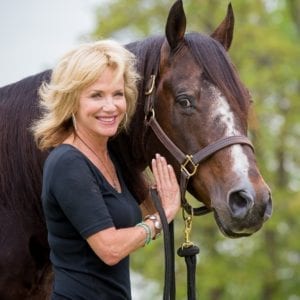 Bradshaw also knew early on she had chosen the right spot for John Simon at Kiowa Ranch with Joan Logan Schroeder.
Bradshaw also knew early on she had chosen the right spot for John Simon at Kiowa Ranch with Joan Logan Schroeder.
“John is my family and my show horse,” Bradshaw said. “It was very hard for me to let go of him for a breeding season because I have always been in control of his care. Joan (pictured right) let me put my trust in her the first year. After I saw the way she cared for him, I was sold. It’s an honor to have a paint stallion stand beside Blazing Hot, Extremely Hot Chips, and all the other amazing quarter horse stallions. Joan has taken John from day one and evolved his breeding career with me into what it is today. You have to know where you are dropping him off. Have a good relationship with those people. It keeps everything consistent. You have returning breeders. They don’t want to be tracking down where your stud is or who is standing him.”
Marketing and Promoting
Getting the word out about stallions is vital to their success. People within the industry want to know their options when breeding mares. Craft and Backes agree on marketing and promoting stallions is becoming more crucial each year.
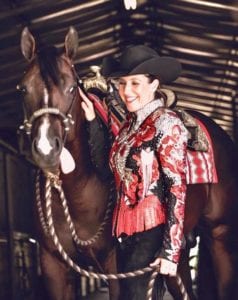 “Marketing and promoting your stud is huge,” Craft said (pictured left). “Before I owned Monkey, I always loved getting hats of all the top stallions. The stallions are like movie stars. They just seem so prestigious and special. To wear the promo gear to promote your favorite one is very cool. It also helps the babies of the stallions that are more well-known. However, a stallion must be able to promote himself by having a presence in the show pen and having what it takes to be a breeding horse by passing on his great qualities to his babies. For promotion, I think online sites like GoHorseShow as well as Facebook and Instagram have been amazing. We have also had Superlative Equine do his videos and many photos of him.”
“Marketing and promoting your stud is huge,” Craft said (pictured left). “Before I owned Monkey, I always loved getting hats of all the top stallions. The stallions are like movie stars. They just seem so prestigious and special. To wear the promo gear to promote your favorite one is very cool. It also helps the babies of the stallions that are more well-known. However, a stallion must be able to promote himself by having a presence in the show pen and having what it takes to be a breeding horse by passing on his great qualities to his babies. For promotion, I think online sites like GoHorseShow as well as Facebook and Instagram have been amazing. We have also had Superlative Equine do his videos and many photos of him.”
 “Marketing in this age of the Internet is a must,” Backes said (pictured right). “The days of driving to the farm and seeing the stud in person are almost gone. You have to have an aggressive marketing plan to keep the stallion’s name and image in front of your potential market all year round, not just in breeding season. You must keep your stallion’s image in front of people by advertising when he is no longer in the pen to win the trophy. Do picture ads of him, his babies and success stories. Change up your ads if you can to keep them interesting. Post videos of him and his babies. Send out clever breeding incentives and stallion promotional material.”
“Marketing in this age of the Internet is a must,” Backes said (pictured right). “The days of driving to the farm and seeing the stud in person are almost gone. You have to have an aggressive marketing plan to keep the stallion’s name and image in front of your potential market all year round, not just in breeding season. You must keep your stallion’s image in front of people by advertising when he is no longer in the pen to win the trophy. Do picture ads of him, his babies and success stories. Change up your ads if you can to keep them interesting. Post videos of him and his babies. Send out clever breeding incentives and stallion promotional material.”
Advice
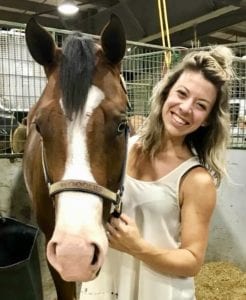 Each of these stallion owners had a little piece of information for anyone wanting to begin their journey of owning a stud.
Each of these stallion owners had a little piece of information for anyone wanting to begin their journey of owning a stud.
“Find the right horse to fit the bill,” Bradshaw said. “If it is what you want, then go with it. You don’t always have to go with the norm and what everyone else is doing. Be independent in the breeding.”
“You need to work with people you trust and know,” Nicoletti said (pictured left). “I think that is the key. It takes a village and you really need to have a good team behind you.”
“Go into owning a stallion for the right reasons,” Backes said. “Recognize his faults as well as his assets. Know that it is usually a long and expensive road ahead. Believe one hundred percent in that stallion.”
“The biggest advice I have for people wanting to own their stallion is to find a mentor,” Craft said. “Find a person that you have known and trusted for a long time and listen to their advice.”
Stay tuned for Part 2 of our “Ask The Stallion Owner” series which will discuss many topics such as the pros and cons of owning a stallion and choosing the appropriate price for your stud fee.
Photos © Impulse Photography, Shane Rux, Superlative Equine, Debbi Trubee, Holt Graham-Pope
About the Author: GoHorseShow writer, Courtney Hall is a graduate student at Missouri State University. She is obtaining a Master’s Degree in Agriculture with research in Agricultural Communications. She started showing the APHA & AQHA all around circuit as a youth and continues today as an amateur.


